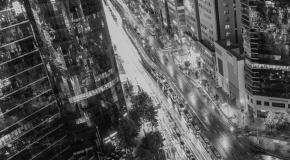The Safe Cities Index 2019 is a report from The Economist Intelligence Unit, sponsored by NEC Corporation. The report is based on the third iteration of the index, which ranks 60 cities across 57 indicators covering digital security, health security, infrastructure security and personal security. The index was devised and constructed by Vaibhav Sahgal and Divya Sharma Nag. The report was written by Paul Kiestra and edited by Naka Kondo and Chris Clague.
Safe Cities Index 2019: An award-winning programme on urban security
Naka is an editorial manager at Economist Impact, based in Tokyo. As the project lead of the Back to Blue initiative, her focus coverage range from sustainability, ocean health, and longevity, among other issues. Before joining The Economist Group, after a brief period sitting in the advisory committee for the Japan Cabinet Office, Naka dedicated seven years in the Japanese Equities business where she communicated closely with Japanese companies and institutional investors around the world. As a journalist, Naka's work appears in The Bungei Shunju, one of the largest publications in Japan, with more than 80 pieces published on topics ranging from economics, politics and culture. Naka's work has been featured in 3 Japanese national newspapers in 2021. Naka has studied at the London School of Economics and Political Science (BSc Maths&Philosophy transferring to BSc Sociology) and the University of Tokyo (BA Social Psychology). She is also a journalism graduate of the Undergraduate Research Program at the Graduate School of Interdisciplinary Information Studies at the University of Tokyo.
Related content

Safe Cities Index 2017: Security in a rapidly urbanising world
In many respects, it’s the very success of cities, in their role as global social and economic hubs, that makes them more vulnerable. As rural residents head for the city in developing countries—which for purposes here we define as non-OECD countries, with the exception of Singapore—and wealthy global capitals draw in international talent, vast demographic shifts are creating cities with previously unimagined population sizes. In 2016, there were 31 megacities—cities with more than 10m inhabitants. This is projected to rise to 41 by 2030.1
And size matters. While cities generate economic activity, the security challenges they face expand and intensify as their populations rise. These include growing pressure on housing supply (prompting the spread of slums) and services such as healthcare, transport, and water and power infrastructure.
Man-made risks are also growing. As tragic recent events in European cities such as London, Paris and Barcelona have demonstrated, high profile, wealthy urban centres are becoming targets for terrorist activities. And as income divides widen, growing inequalities can create tensions that contribute to violent outbursts such as the 2011 London riots.
Meanwhile, another major shift has come to the fore: the rapid deployment of digital technologies in pursuit of the so-called “smart city”. The technologies no doubt bring benefits. As part of the Internet of Things (IoT) technologies, sensors collect and wirelessly transmit data from physical objects, delivering new insights into city operations and permitting remote and more efficient management of infrastructure and services. Connecting apartments and office buildings to the electricity grid via smart meters, for example, delivers energy efficiency and cost savings.
And with the spread of closed-circuit televisions (CCTVs) and webcams around cities, technologies such as artificial intelligence and data analytics can greatly enhance the capabilities of law enforcement agencies to combat urban crime and terrorism.
Yet the rush to embrace smart city technologies also creates vulnerabilities if investments in digital technologies are not accompanied by commensurate investments in cybersecurity. Wealthy cities are making investments, albeit to varying degrees, but security often comes lower on the list of spending priorities for cities with already stretched finances.
The consequences of neglecting cybersecurity could be dire. For example, if hackers were to shut down the power supply, an entire city would be left in chaos. This prospect is something city officials now need to plan against.
Cities are also defined by the complex, interlinked nature of their systems and infrastructure. This complexity has a bearing on safety. For example, experts are uncovering links between the quality of housing and the health of citizens. And while terrorist attacks are what make headlines, traffic accidents are a greater day-to-day danger for urban residents. Natural forces are also coming in to play as climate change poses new risks to cities, with extreme weather events becoming an even greater threat, as illustrated by the devastation Hurricane Harvey just delivered to Houston, Texas.
The 2017 Safe Cities Index retains the four categories of security from the 2015 version— digital, health, infrastructure and physical. However, we have added six new indicators and expanded the index to cover 60 cities, up from 50 in 2015.
Click Here to download a workbook which allows users to personalize the underlying data used to build the Safe Cities Index 2017.
This white paper is part of a series called "Safe Cities Index". Click Here to read the full series.

The Safe Cities Index 2015
The Economist Intelligence Unit has launched a new index measuring urban safety and security. The Safe Cities Index 2015, sponsored by NEC, ranks 50 cities worldwide across five continents.
The Index introduces a new definition of urban safety. Every city’s ranking is based on an average score across four categories: digital security, health security, infrastructure safety and personal safety.
Visit the dedicated hub on economist.com 日本語版サマリーはこちらGo to the Safe Cities Hub for more: Watch an interview with the governor of Tokyo (video, Japanese with English subtitles) Access the interactive data workbook to generate personalised city comparisons Watch EIU editors from across the world provide a personal take on city safety Find out what a chief resilience officer does Download the Safe Cities Index 2015 white paper

Safe Cities Index 2019
Cities across the globe are growing in size and in terms of how connected they are. Which cities are best at keeping their citizens safe and how do they do it? An updated version of the Safe Cities Index 2017, the 2019 index covers 60 cities across the globe and defines how to measure security in a rapidly urbanising world.
Visit the Safe Cities hub for more interactive content >>
